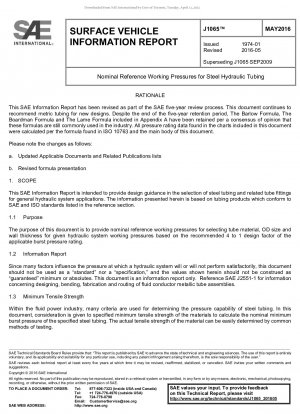SAE J1065-2016
Nominal Reference Working Pressures for Steel Hydraulic Tubing
- Standard No.
- SAE J1065-2016
- Release Date
- 2016
- Published By
- SAE - SAE International
- Status
- Replace By
- SAE J1065-2022
- Latest
- SAE J1065-2022
- Scope
- This SAE Information Report is intended to provide design guidance in the selection of steel tubing and related tube fittings for general hydraulic system applications. The information presented herein is based on tubing products which conform to SAE and ISO standards listed in the reference section. Purpose The purpose of this document is to provide nominal reference working pressures for selecting tube material@ OD size and wall thickness for given hydraulic system working pressures based on the recommended 4 to 1 design factor of the applicable burst pressure rating. Information Report Since many factors influence the pressure at which a hydraulic system will or will not perform satisfactorily@ this document should not be used as a ??standard?? nor a ??specification@?? and the values shown herein should not be construed as ??guaranteed?? minimum or absolutes. This document is an information report only. Reference SAE J2551-1 for information concerning designing@ bending@ fabrication and routing of fluid conductor metallic tube assemblies. Minimum Tensile Strength Within the fluid power industry@ many criteria are used for determining the pressure capability of steel tubing. In this document@ consideration is given to specified minimum tensile strength of the materials to calculate the nominal minimum burst pressure of the specified steel tubing. The actual tensile strength of the material can be easily determined by common methods of testing. Straight Tube Sections The nominal reference working pressures listed in this document are for straight tube sections of the listed tubing materials only. Factors such as the thinning of tube walls due to forming operations@ shock loads@ and vibration characteristics of the system should also be considered when designing all hydraulic tubes and tube assemblies@ especially in high pressure applications. Operating at 100% of the Reference Working Pressures When designing systems that operate at 100% of the charted reference working pressure@ in conjunction with the materials being subjected to bending@ cold forming@ wall thinning@ brazing@ welding@ side loads@ shock loads and extreme vibrations@ the maximum yield strength of the material may be compromised@ which may lead to premature failure of the tube material. Therefore@ a good recommended practice is to design hydraulic systems to operate at a level less than the calculated maximum reference working pressures of the materials used. This diminished level may vary from application to application@ depending on the operating conditions@ pressure spikes and designer discretion@ 90% is commonly used. Endurance Testing As it is impractical to specify in this report guaranteed allowable working pressures that will satisfy all design criteria for every hydraulic system endurance testing in accordance with ISO 19879 is recommended. See SAE J2593 Information Report for the Installation of Fluid Conductors and Connectors for installation guidance@ recommended assembly sequence and recommended tightening torque values.
SAE J1065-2016 history
- 2022 SAE J1065-2022 Nominal Reference Working Pressures for Steel Hydraulic Tubing
- 2016 SAE J1065-2016 Nominal Reference Working Pressures for Steel Hydraulic Tubing
- 2009 SAE J1065-2009 Nominal Reference Working Pressures for Steel Hydraulic Tubing
- 2003 SAE J1065-2003 Nominal Reference Working Pressures for Steel Hydraulic Tubing
- 1995 SAE J1065-1995 PRESSURE RATINGS FOR HYDRAULIC TUBING AND FITTINGS
- 1992 SAE J1065-1992 Nominal Reference Working Pressures for Steel Hydraulic Tubing
